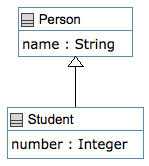



User Manual [Previous] [Next]
isA clause
The isA keyword is used to denote an inheritance relationship (generalization) between two classes, or a class and the interfaces it implements, or a class and the traits it includes.
This corresponds to keywords such as 'extends', 'subclass', etc. in other languages. The isA keyword was chosen so as to be independent of other languages, and due to the strong conceptual similarity between interfaces, classes and traits.
Note that it is possible to avoid using the isA keyword for class generalization, by directly embedding a subclass inside a superclass. Note that this does not create an inner class in the Java sense, but instead creates a subclass. The two examples below give identical results.
The following is how a generalization appears in UML. The corresponding Umple is below. Note that in UmpleOnline, the expected layout for generalizations places superclasses above subclasses.

Example Showing Student as a Subclass of Person
// A superclass-subclass relationship defined using the isA keyword
class Person
{
name;
}
class Student
{
isA Person;
Integer number;
}
Load the above code into UmpleOnline
The Same Model as Above but Using Nesting Instead of IsA
// A superclass-subclass relationship defined
// by embedding the subclass in the superclass
class Person
{
name;
class Student
{
Integer number;
}
}
Load the above code into UmpleOnline
Syntax
// Generalization and inheritance isAclause
isA- : [[singleIsA]] | [[multipleIsA]]
singleIsA- : isA [[isAName]] ( , isA [[isAName]] )* ;
multipleIsA- : isA [[isAName]] ( , [[isAName]] )* ;